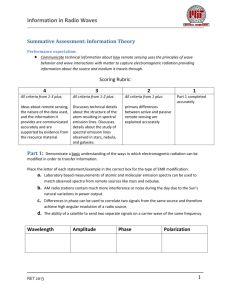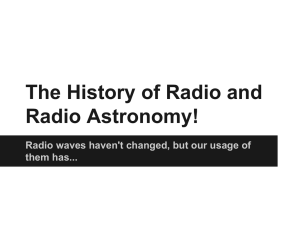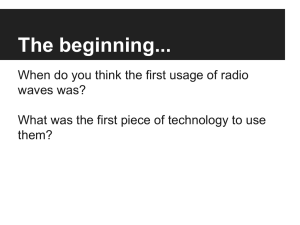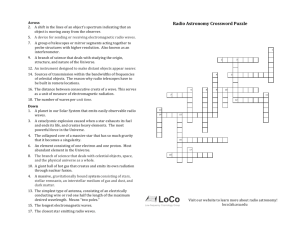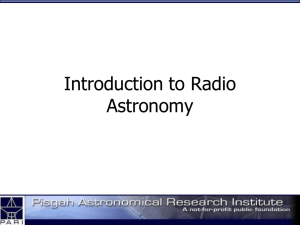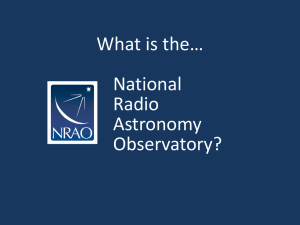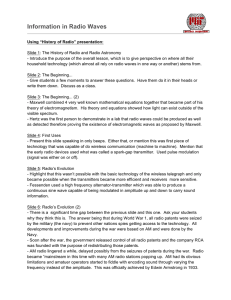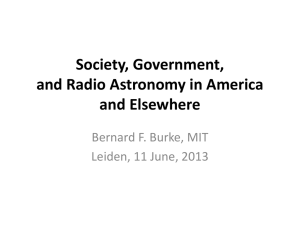"Prehistory of Radio Astronomy." Prehistory of Radio Astronomy
advertisement
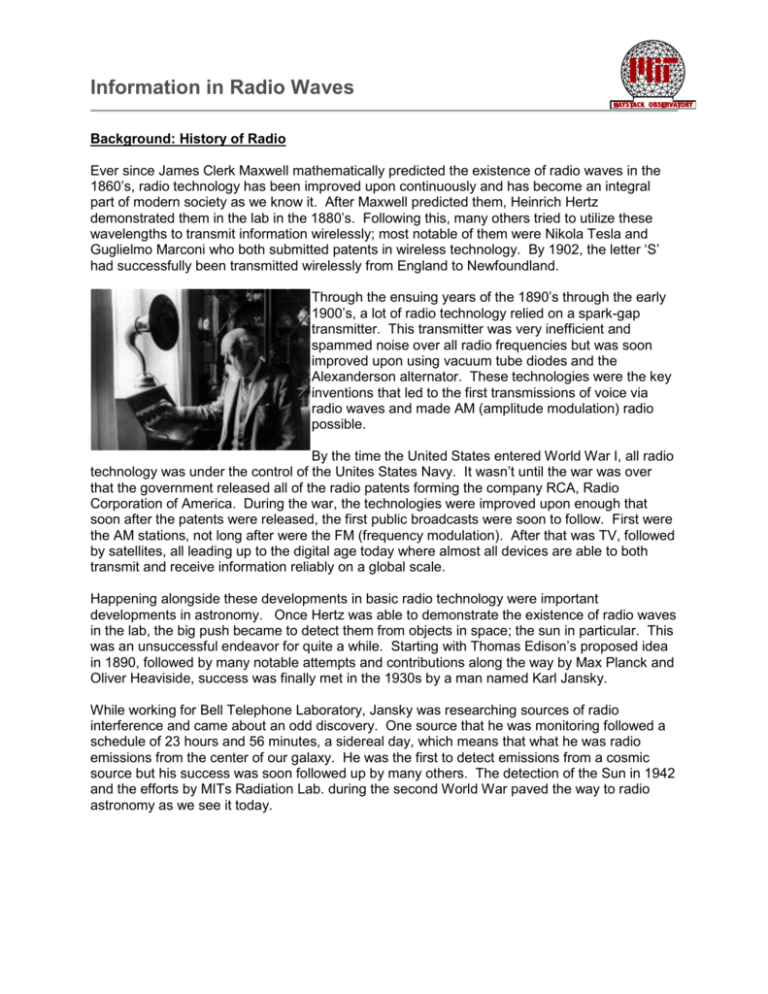
Information in Radio Waves Background: History of Radio Ever since James Clerk Maxwell mathematically predicted the existence of radio waves in the 1860’s, radio technology has been improved upon continuously and has become an integral part of modern society as we know it. After Maxwell predicted them, Heinrich Hertz demonstrated them in the lab in the 1880’s. Following this, many others tried to utilize these wavelengths to transmit information wirelessly; most notable of them were Nikola Tesla and Guglielmo Marconi who both submitted patents in wireless technology. By 1902, the letter ‘S’ had successfully been transmitted wirelessly from England to Newfoundland. Through the ensuing years of the 1890’s through the early 1900’s, a lot of radio technology relied on a spark-gap transmitter. This transmitter was very inefficient and spammed noise over all radio frequencies but was soon improved upon using vacuum tube diodes and the Alexanderson alternator. These technologies were the key inventions that led to the first transmissions of voice via radio waves and made AM (amplitude modulation) radio possible. By the time the United States entered World War I, all radio technology was under the control of the Unites States Navy. It wasn’t until the war was over that the government released all of the radio patents forming the company RCA, Radio Corporation of America. During the war, the technologies were improved upon enough that soon after the patents were released, the first public broadcasts were soon to follow. First were the AM stations, not long after were the FM (frequency modulation). After that was TV, followed by satellites, all leading up to the digital age today where almost all devices are able to both transmit and receive information reliably on a global scale. Happening alongside these developments in basic radio technology were important developments in astronomy. Once Hertz was able to demonstrate the existence of radio waves in the lab, the big push became to detect them from objects in space; the sun in particular. This was an unsuccessful endeavor for quite a while. Starting with Thomas Edison’s proposed idea in 1890, followed by many notable attempts and contributions along the way by Max Planck and Oliver Heaviside, success was finally met in the 1930s by a man named Karl Jansky. While working for Bell Telephone Laboratory, Jansky was researching sources of radio interference and came about an odd discovery. One source that he was monitoring followed a schedule of 23 hours and 56 minutes, a sidereal day, which means that what he was radio emissions from the center of our galaxy. He was the first to detect emissions from a cosmic source but his success was soon followed up by many others. The detection of the Sun in 1942 and the efforts by MITs Radiation Lab. during the second World War paved the way to radio astronomy as we see it today. Information in Radio Waves Reference: "Art 2 @ Penn State: Working Group 8." Art 2 @ Penn State: Working Group 8. Web. 16 July 2014. <http://www.personal.psu.edu/jtk187/art2index.htm>. Bellis, Mary. "The History of Radio - Page 2." About.com Inventors. About.com, 16 May 2014. Web. 16 July 2014. <http://inventors.about.com/od/rstartinventions/a/radio_2.htm>. "The History of Radio." The Sonos Blog RSS 092. Web. 16 July 2014. <http://blog.sonos.com/culture/the-history-of-radio/>. "NRAO: Revealing the Hidden Universe." NRAO: Revealing the Hidden Universe. Web. 16 July 2014. <http://www.nrao.edu/index.php/learn/radioastronomy/radioastronomyhistory>. "Prehistory of Radio Astronomy." Prehistory of Radio Astronomy. Web. 16 July 2014. <http://www.nrao.edu/whatisra/hist_prehist.shtml>. Standards: HS-PS2-1 Analyze data to support the claim that Newton’s second law of motion describes the mathematical relationship among the net force on a macroscopic object, its mass, and its acceleration. HS-PS4-5 Communicate technical information about how some technological devices use the principles of wave behavior and wave interactions with matter to transmit and capture information and energy. Enrichment: - Article on the history of Mobile Radio: ○ http://transition.fcc.gov/omd/history/radio/documents/short_history.pdf - Interesting site detailing the life and developments of Guglielmo MarconI: ○ http://www.marconicalling.com/introsting.htm - History and Interviews on MIT Radiation Laboratory: ○ http://www.ieeeghn.org/wiki/index.php/Oral-History:MIT_Radiation_Laboratory - Short 2-minute video on the History of Radio: ○ http://www.history.com/topics/radio-and-television/videos#radio-creates-a-culturalphenomenon - Medium / High level video explaining the formation of a radio wave: ○ http://www.youtube.com/watch?v=aAcDM2ypBfE - Build your own crystal radio project / science fair idea: ○ http://www.sciencebuddies.org/science-fair-projects/project_ideas/Elec_p014.shtml Unit Breakdown: This unit is a short basic collections of works intending to give students a basic understanding and appreciation into how technologies involving the use of light waves has developed over the years. Included is a presentation that gives a “brief” overview of many scientists and their contributions to the radio world. It is suggested to pick and choose slides covering the scientists of your choosing instead of trudging through the presentation as a whole. Along with the presentation is a “Teacher Notes” guide to each slide in the powerpoint and a basic pre and post assessment. An activity has been included that has students build their own “radio” and encode/decode information from then. It is important to note that pieces of this unit, especially the activity, align well with the information theory unit also included in this set.

